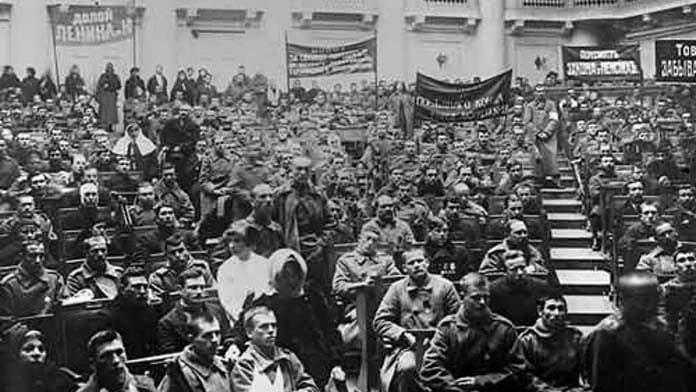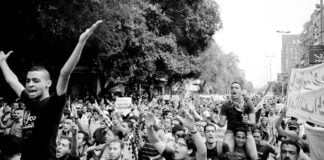The history of workers’ struggles shows the possibility of a socialism based on mass democratic control of society, writes Judy Cox
Faced with a world of war, climate chaos and spiralling inequality, there is no shortage of utopias being put forward as alternatives to capitalism. Among many recent suggestions on the left are “degrowth communism”, “fully automated luxury communism”, and “post work socialism”.
But what’s largely absent from these ideas is the question of the state. They simply ignore it or treat it as a neutral institution capable of supporting a transition to a new social order.
At the same time, we are seeing in Gaza the brutal violence that the world’s most powerful states are prepared to deal out. The movement for Palestine as well as climate activists here have also come up against the power of the state.
The Black Lives Matter movement raised calls for the abolition of the police and prisons.
But if we’re going to break with capitalism we have to ask, how do we break the power of the capitalist state? And what’s the alternative to it? The history of working class struggles provides some answers.
In 1871, a revolt in France saw the first collective of working and poor people develop a practical alternative to the capitalist state. The Parisian poor drove out the generals, officials and bureaucrats who had governed their city and created a Commune based on universal male suffrage.
The Commune abolished the standing army and the police and replaced them with a democratically elected militia. Councillors were elected from every ward of the city. They were instantly recallable, and no official earned more than the average workers’ wage.
In its brief existence, the Commune passed a range of progressive reforms which benefited the workers and the urban poor.
In 1872 Marx, a passionate supporter of the Commune, made the only amendment to the Communist Manifesto of 1848. He inserted a clause that said the working class could not lay hold of the existing state machine and use it for its own purposes—but must smash it instead.
This sort of democracy from below was extended by Russian workers during the revolution of 1905. Russia was a semi-feudal country, but a huge working class had developed in industrial centres of Moscow and St Petersburg.
During the revolution mass strikes saw the creation of new bodies, which could facilitate organising across different industries and provide vital services and supplies. These workers’ councils—known as soviets, the Russian word for council—began to develop both economic and political demands for change. This was summed up by the slogan, “Eight hours and a gun.”
Only 12 years later the February Revolution of 1917 brought down the old Tsarist dictatorship and brought to power a Provisional Government. But it led to “dual power” between this new authority and the soviets, which once again emerged as the embryo of a workers’ state.
Revolution was not an event—it was a process.
The life-or-death contest between the old, rotten and decaying government and new workers’ councils meant the ever-present threat of violent counter-revolution.
Throughout the summer of 1917, the authority of the Provisional Government ebbed away. It ignored demands for peace and launched new and disastrous military offensives in the First World War. It looked to the old Tsar’s generals to lend it authority and imprisoned socialists and revolutionaries.
At the same time, workers increasingly turned to the soviets to resolve their problems.
But “dual power” was unsustainable. It could lead to a counter-revolution that would crush all hope for a better society. Or it could lead to a second revolution, which could abolish the repressive institutions of the state and give the soviets power over all aspects of society. When the Bolshevik revolutionary socialist party won majority support inside the soviets, the soviets launched the October Revolution of 1917.
Cutting the wires of the state
The success of the revolution depended on overcoming the repressive power of the state. Lenin wrote State and Revolution and a pamphlet, Can the Bolsheviks Retain State Power, which was published a week before the revolution in October 1917.
Lenin argued that the working class had two tasks. Firstly, it must “smash everything that is oppressive, routine, incorrigibly bourgeois in the old state apparatus.” But this destructive act had to be accompanied by a creative one. The working class must create “its own, new apparatus, the Soviets of Workers’, Soldiers’ and Peasants’ Deputies”.
Lenin distinguished between the repressive institutions of the state, the “special bodies of armed men” that must be abolished and the useful departments that the state controlled. These “must be wrested from the control of the capitalists; the capitalists and the wires they pull must be cut off, lopped off, chopped away from this apparatus”. These useful aspects of the state must be “expanded, made more comprehensive, and nation-wide”.
Lenin insisted that monopoly capitalism created the tools which would enable workers to run society. National infrastructures could be taken over by the workers to provide electricity and a national network of banks.
The tools bequeathed by modern capitalist states to a future workers’ state far surpass this. Imagine bringing global health systems under workers’ control and using them to get vaccines and medicines to those who need them.
A workers’ state will explore the potential of social media platforms and AI to address human needs. Resources could be diverted from useless, wasteful and harmful industries and allocated to creating new ways of living.
Capitalist states depend on the passivity of the population, on their alienation from state bureaucracies and apathy towards political processes. In contrast, a worker’s state would only survive with the active commitment of working class people.
The new apparatus created by the Russian working class proved to be uniquely responsive to those it represented.
In 1918 US journalist John Reed described, “There is today in Moscow and throughout all the cities and towns of the Russian land a highly complex political structure, which is upheld by the vast majority of the people, and which is functioning as well as any newborn popular government ever functioned.”
The councils were necessarily inclusive. Reed observed that “cooks and waiters, street sweepers, courtyard servants or cab drivers who got organised could request representation”.
The soviets, he wrote, “Express the political will of the masses, not only in the All-Russian Congresses for the whole country, but also in their own localities. This decentralisation exists because the local soviets create the central government, not the central government the local soviets.”
Delegates were subject to instant recall which, according to Reed meant, “No political body more sensitive and responsive to the popular will was ever invented.”
The workers’ councils could also take economic as well as political decisions. In a workers’ state, those who produce the wealth will democratically control what they produce, in discussion with those who need goods and services and those sharing the environment.
Democratic bodies with specific roles in production or consumption could combine with democratic assemblies representing people living in local, regional, and international areas.
Dictatorship of the proletariat
Marx called the workers’ state the “dictatorship of the proletariat”. Any idea of dictatorship can seem at odds with the idea of emancipation. But as Marxist economists Michael Roberts and Guglielmo Carchedi argue, “Dictatorship of the proletariat would mean the democratic rule of the majority of working people ‘dictating’ to capital, not vice versa.”
In the initial period following the overthrow of the capitalist class, the working class would need a centralised state to suppress counter-revolutionary opposition from within and outside. Such a state will organise economic production and the expansion of welfare, health and education provision. It would also take immediate steps to address historical inequalities of race and gender and colonialism.
The workers’ state will need to prioritise spreading the revolution internationally to survive.
If successful, the workers’ state would not become entrenched. Rather, it would begin to wither away as there would be no need for suppressing counter-revolution. The revolutionary Frederick Engels predicted, “State interference in social relations becomes, in one domain after another, superfluous and then dies down of itself.”
“The state is not abolished,” he wrote. “It withers away.”
This point is worth stressing given the association of Communism with the powerful state machine constructed by Stalin in Russia in the late 1920s.
The Russian Revolution created the potential for a wave of international revolutions, but these failed and it was left isolated. The working class that had made the revolution was decimated and that hollowed out the soviets, the basis of workers’ democracy.
But the Bolshevik party was left in charge of a vast bureaucracy—and this bureaucracy, with Joseph Stalin increasingly in charge, transformed itself into a new ruling class in a state capitalist regime.
Stalin forced through break-neck industrialisation on the backs of the working class in the 1930s. As Russian industry grew, so did the working class. And as class antagonisms grew, so did the repressive apparatus of the state that Stalin needed to consolidate the bureaucracy’s rule.
No blueprint
A socialist society would inevitably be “stamped with the birthmarks of the old society from whose womb it emerges,” as Marx wrote. These would fade as socialism develops and the state withers away.
The revolutionary socialist tradition emphasises how working class people can transform themselves and their ideas as they transform their world. All the creativity struggling to survive among workers today would be liberated to facilitate humanity’s leap from the realm of necessity to the realm of freedom, to develop new ways of living and loving and self-expression.
The nature of work will also be transformed. Marx predicted that in a communist society labour will become not only a means of life, but life’s prime want.
To achieve that, workers do not need blueprints of utopia created by well-meaning socialists.
What they do need to deal effectively with a centralised capitalist state, is a centralised revolutionary party. This sort of organisation can articulate socialist ideas in the broader working class, focus activities where they are most effective, and generalise their best experiences to build for a confrontation with the capitalist state and system.
Republished from Socialist Worker UK





